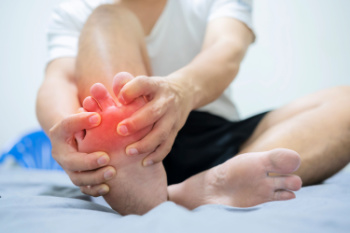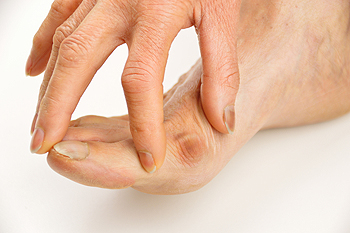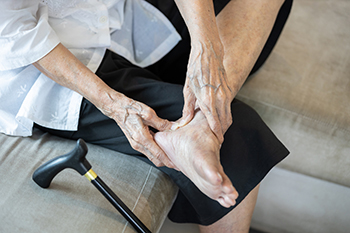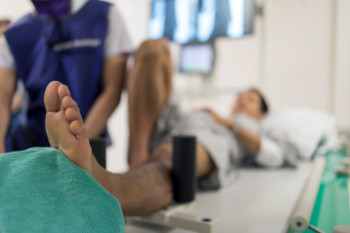Connect With Us
Blog
Items filtered by date: October 2024
Causes of Toe Discomfort

Aching toes can result from various causes, including arthritis, bunions, hammertoes, nerve issues, or even ill-fitting shoes. Conditions like plantar fasciitis, overuse injuries from sports, or long periods of standing may also lead to toe pain. The discomfort can range from mild soreness to sharp, persistent pain, affecting mobility and daily activities. To manage aching toes, it is important to rest and wear comfortable, supportive shoes. A podiatrist can diagnose the underlying cause of toe pain through a thorough exam and imaging scans. They may recommend custom orthotics, targeted exercises, or in severe cases, surgery to address structural problems. Early treatment helps prevent further complications and restores foot function. If you have toe pain that persists or worsens, it is suggested that you visit a podiatrist for care.
Toe pain can disrupt your daily activities. If you have any concerns, contact Emmanuel Bustos, DPM of New York. Our doctor can provide the care you need to keep you pain-free and on your feet.
What Causes Toe Pain?
Most severe toe pain is caused due to a sports injury, trauma from dropping something heavy on the toe, or bumping into something rigid. Other problems can develop over time for various reasons.
Toe pain can be caused by one or more ailments. The most common include:
- Trauma
- Sports injury
- Wearing shoes that are too tight
- Arthritis
- Gout
- Corns and calluses
- Hammertoe
- Bunions
- Blisters
- Ingrown toenails
- Sprains
- Fractures (broken bones)
- Dislocations
When to See a Podiatrist
- Severe pain
- Persistent pain that lasts more than a week
- Signs of infection
- Continued swelling
- Pain that prevents walking
Diagnosis
In many cases the cause of toe pain is obvious, but in others, a podiatrist may want to use more advanced methods to determine the problem. These can range from simple visual inspections and sensation tests to X-rays and MRI scans. Prior medical history, family medical history, and any recent physical traumatic events will all be taken into consideration for a proper diagnosis.
Treatment
Treatments for toe pain and injuries vary and may include shoe inserts, padding, taping, medicines, injections, and in some cases, surgery. If you believe that you have broken a toe, please see a podiatrist as soon as possible.
If you have any questions please feel free to contact our office located in New York, NY . We offer the newest diagnostic tools and technology to treat your foot and ankle needs.
Do Your Child's Feet Hurt?
Understanding Bunions

Bunions are bony protrusions that form at the base of the big toe, causing it to angle inward toward the other toes. This misalignment can lead to pain, swelling, and difficulty finding comfortable footwear. As bunions progress, they can also result in inflammation and increased pressure on the other toes, leading to additional foot problems. The causes of bunions can vary, but they are often linked to genetics, improper footwear, especially narrow or high-heeled shoes, and certain medical conditions. While conservative treatments like padding, orthotics, and wearing appropriate shoes can provide relief, severe cases may require surgical intervention. If you are experiencing foot pain or notice the development of a bunion, it is important to address the issue early. Do not let bunions disrupt your daily life. It is suggested you schedule an appointment with a podiatrist. They can assess your condition, recommend treatment options, and help you regain foot comfort.
If you are suffering from bunions, contact Emmanuel Bustos, DPM of New York. Our doctor can provide the care you need to keep you pain-free and on your feet.
What Is a Bunion?
A bunion is formed of swollen tissue or an enlargement of boney growth, usually located at the base joint of the toe that connects to the foot. The swelling occurs due to the bones in the big toe shifting inward, which impacts the other toes of the foot. This causes the area around the base of the big toe to become inflamed and painful.
Why Do Bunions Form?
Genetics – Susceptibility to bunions are often hereditary
Stress on the feet – Poorly fitted and uncomfortable footwear that places stress on feet, such as heels, can worsen existing bunions
How Are Bunions Diagnosed?
Doctors often perform two tests – blood tests and x-rays – when trying to diagnose bunions, especially in the early stages of development. Blood tests help determine if the foot pain is being caused by something else, such as arthritis, while x-rays provide a clear picture of your bone structure to your doctor.
How Are Bunions Treated?
- Refrain from wearing heels or similar shoes that cause discomfort
- Select wider shoes that can provide more comfort and reduce pain
- Anti-inflammatory and pain management drugs
- Orthotics or foot inserts
- Surgery
If you have any questions, please feel free to contact our office located in New York, NY . We offer the newest diagnostic and treatment technologies for all your foot care needs.
The Importance of Foot Care For the Elderly

As people age, foot care becomes increasingly important to maintain mobility and comfort. Common issues among the elderly include bunions, corns, and blisters. Blistering skin lesions on the feet of the elderly can be a common and concerning issue. These lesions, often filled with fluid, can result from various factors, including friction, pressure, and decreased skin integrity associated with aging. The skin of elderly individuals tends to become thinner, drier, and more fragile over time, making it more susceptible to damage and blister formation. If left untreated, blistering skin lesions can increase the risk of infection and other complications, particularly in elderly individuals with compromised immune systems. If you are elderly and experiencing such blisters, it is suggested that you schedule an appointment with a podiatrist for a proper diagnosis and treatment.
Proper foot care is something many older adults forget to consider. If you have any concerns about your feet and ankles, contact Emmanuel Bustos, DPM from New York. Our doctor can provide the care you need to keep you pain-free and on your feet.
The Elderly and Their Feet
As we age we start to notice many changes in our body, but the elder population may not notice them right away. Medical conditions may prevent the elderly to take notice of their foot health right away. Poor vision is a lead contributor to not taking action for the elderly.
Common Conditions
- Neuropathy – can reduce feeling in the feet and can hide many life-threatening medical conditions.
- Reduced flexibility – prevents the ability of proper toenail trimming, and foot cleaning. If left untreated, it may lead to further medical issues.
- Foot sores – amongst the older population can be serious before they are discovered. Some of the problematic conditions they may face are:
- Gouging toenails affecting nearby toe
- Shoes that don’t fit properly
- Pressure sores
- Loss of circulation in legs & feet
- Edema & swelling of feet and ankles
Susceptible Infections
Diabetes and poor circulation can cause general loss of sensitivity over the years, turning a simple cut into a serious issue.
If you have any questions please feel free to contact our office located in New York, NY . We offer the newest diagnostic and treatment technologies for all your foot and ankle needs.
Facts About Foot Drop

Foot drop is a medical condition characterized by difficulty lifting the front part of the foot, which can lead to various challenges in mobility. Individuals with foot drop may experience symptoms such as tripping frequently, a noticeable limp, and numbness in the affected foot. These symptoms can make walking cumbersome and may cause individuals to drag their toes or catch them on the ground, increasing the risk of falls. Additionally, those with foot drop may struggle to keep their shoes on securely, leading to discomfort and further mobility issues. This condition can result from various underlying causes, including nerve injuries, muscle disorders, or neurological conditions. Recognizing the symptoms of foot drop is essential, as early intervention can improve mobility and quality of life. If you notice symptoms of foot drop, it is strongly suggested that you consult a podiatrist who can help you to manage this condition.
Foot Pain
Foot pain can be extremely painful and debilitating. If you have a foot pain, consult with Emmanuel Bustos, DPM from New York. Our doctor will assess your condition and provide you with quality foot and ankle treatment.
Causes
Foot pain is a very broad condition that could be caused by one or more ailments. The most common include:
- Bunions
- Hammertoes
- Plantar Fasciitis
- Bone Spurs
- Corns
- Tarsal Tunnel Syndrome
- Ingrown Toenails
- Arthritis (such as Gout, Rheumatoid, and Osteoarthritis)
- Flat Feet
- Injury (from stress fractures, broken toe, foot, ankle, Achilles tendon ruptures, and sprains)
- And more
Diagnosis
To figure out the cause of foot pain, podiatrists utilize several different methods. This can range from simple visual inspections and sensation tests to X-rays and MRI scans. Prior medical history, family medical history, and any recent physical traumatic events will all be taken into consideration for a proper diagnosis.
Treatment
Treatment depends upon the cause of the foot pain. Whether it is resting, staying off the foot, or having surgery; podiatrists have a number of treatment options available for foot pain.
If you have any questions, please feel free to contact our office located in New York, NY . We offer the newest diagnostic and treatment technologies for all your foot care needs.
Is It a Foot Stress Fracture or Tendonitis?

Tendonitis and stress fractures are both foot issues that can lead to significant pain. Tendonitis is the inflammation of tendons, which are the tissues that connect muscles to bones. This inflammation often results in pain, swelling, and restricted movement in the affected area. Stress fractures are tiny cracks in the bones, typically occurring in the long bones of the foot, or metatarsals. Stress fractures result from repetitive pounding or overuse and are common among runners or other athletes. These fractures can cause sharp, localized pain, especially when placing weight on the affected foot. Differentiating between stress fractures and tendonitis is important because they call for different types of treatment. Tendonitis treatment is aimed at reducing inflammation, while stress fractures require rest and gradual healing. If you are experiencing foot pain that impedes your activities, it is suggested that you schedule an appointment with a podiatrist for a diagnosis and treatment.
Activities where too much pressure is put on the feet can cause stress fractures. To learn more, contact Emmanuel Bustos, DPM from New York. Our doctor can provide the care you need to keep your pain free and on your feet.
Dealing with Stress Fractures of the Foot and Ankle
Stress fractures occur in the foot and ankle when muscles in these areas weaken from too much or too little use. The feet and ankles then lose support when walking or running from the impact of the ground. Since there is no protection, the bones receive the full impact of each step. Stress on the feet can cause cracks to form in the bones, thus creating stress fractures.
What Are Stress Fractures?
Stress fractures occur frequently in individuals whose daily activities cause great impact on the feet and ankles. Stress factors are most common among:
- Runners
- People affected with Osteoporosis
- Tennis or basketball players
- Gymnasts
- High impact workouts
Symptoms
Pain from the fractures occur in the area of the fractures and can be constant or intermittent. It will often cause sharp or dull pain with swelling and tenderness. Engaging in any kind of activity which involves high impact will aggravate pain.
If you have any questions please feel free to contact our office located in New York, NY . We offer the newest diagnostic and treatment technologies for all your foot and ankle needs.
